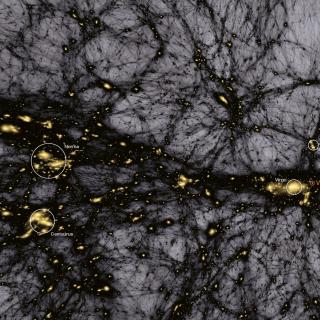Bibcode
Favole, G.; Gonzalez-Perez, V.; Ascasibar, Y.; Corcho-Caballero, P.; Montero-Dorta, A. D.; Benson, A. J.; Comparat, J.; Cora, S. A.; Croton, D.; Guo, H.; Izquierdo-Villalba, D.; Knebe, A.; Orsi, Á.; Stoppacher, D.; Vega-Martínez, C. A.
Referencia bibliográfica
Astronomy and Astrophysics
Fecha de publicación:
3
2024
Revista
Número de citas
6
Número de citas referidas
4
Descripción
Context. Nebular emission lines are powerful diagnostics for the physical processes at play in galaxy formation and evolution. Moreover, emission-line galaxies (ELGs) are one of the main targets of current and forthcoming spectroscopic cosmological surveys.
Aims: We investigate the contributions to the line luminosity functions (LFs) of different galaxy populations in the local Universe, providing a benchmark for future surveys of earlier cosmic epochs.
Methods: The large statistics of the observations from the SDSS DR7 main galaxy sample and the MPA-JHU spectral catalog enabled us to precisely measure the Hα, Hβ, [O II], [O III], and, for the first time, the [N II], and [S II] emission-line LFs over ∼2.4 Gyrs in the low-z Universe, 0.02 < z < 0.22. We present a generalized 1/Vmax LF estimator capable of simultaneously correcting for spectroscopic, r-band magnitude, and emission-line incompleteness. We studied the contribution to the LF of different types of ELGs classified using two methods: (i) the value of the specific star formation rate (sSFR), and (ii) the line ratios on the Baldwin-Phillips-Terlevich (BPT) and the WHAN (i.e., Hα equivalent width, EWHα, versus the [N II]/Hα line ratio) diagrams.
Results: The ELGs in our sample are mostly star forming, with 84 percent having sSFR > 10−11 yr−1. When classifying ELGs using the BPT+WHAN diagrams, we find that 63.3 percent are star forming, only 0.03 are passively evolving, and 1.3 have nuclear activity (Seyfert). The rest are low-ionization narrow emission-line regions (LINERs) and composite ELGs. We found that a Saunders function is the most appropriate to describe all of the emission-line LFs, both observed and dust-extinction-corrected (i.e., intrinsic). They are dominated by star-forming regions, except for the bright end of the [O III] and [N II] LFs (i.e., L[N II] > 1042 erg s−1, L[O III] > 1043 erg s−1), where the contribution of Seyfert galaxies is not negligible. In addition to the star-forming population, composite galaxies, and LINERs are the ones that contribute the most to the ELG numbers at L < 1041 erg s−1. We do not observe significant evolution with redshift of our ELGs at 0.02 < z < 0.22. All of our results, including data points and analytical fits, are publicly available.
Conclusions: Local ELGs are dominated by star-forming galaxies, except for the brightest [N II] and [O III] emitters, which have a large contribution of Seyfert galaxies. The local line luminosity functions are best described by Saunders functions. We expect these two conclusions to hold up at higher redshifts for the ELG targeted by current cosmological surveys, such as DESI and Euclid.
Aims: We investigate the contributions to the line luminosity functions (LFs) of different galaxy populations in the local Universe, providing a benchmark for future surveys of earlier cosmic epochs.
Methods: The large statistics of the observations from the SDSS DR7 main galaxy sample and the MPA-JHU spectral catalog enabled us to precisely measure the Hα, Hβ, [O II], [O III], and, for the first time, the [N II], and [S II] emission-line LFs over ∼2.4 Gyrs in the low-z Universe, 0.02 < z < 0.22. We present a generalized 1/Vmax LF estimator capable of simultaneously correcting for spectroscopic, r-band magnitude, and emission-line incompleteness. We studied the contribution to the LF of different types of ELGs classified using two methods: (i) the value of the specific star formation rate (sSFR), and (ii) the line ratios on the Baldwin-Phillips-Terlevich (BPT) and the WHAN (i.e., Hα equivalent width, EWHα, versus the [N II]/Hα line ratio) diagrams.
Results: The ELGs in our sample are mostly star forming, with 84 percent having sSFR > 10−11 yr−1. When classifying ELGs using the BPT+WHAN diagrams, we find that 63.3 percent are star forming, only 0.03 are passively evolving, and 1.3 have nuclear activity (Seyfert). The rest are low-ionization narrow emission-line regions (LINERs) and composite ELGs. We found that a Saunders function is the most appropriate to describe all of the emission-line LFs, both observed and dust-extinction-corrected (i.e., intrinsic). They are dominated by star-forming regions, except for the bright end of the [O III] and [N II] LFs (i.e., L[N II] > 1042 erg s−1, L[O III] > 1043 erg s−1), where the contribution of Seyfert galaxies is not negligible. In addition to the star-forming population, composite galaxies, and LINERs are the ones that contribute the most to the ELG numbers at L < 1041 erg s−1. We do not observe significant evolution with redshift of our ELGs at 0.02 < z < 0.22. All of our results, including data points and analytical fits, are publicly available.
Conclusions: Local ELGs are dominated by star-forming galaxies, except for the brightest [N II] and [O III] emitters, which have a large contribution of Seyfert galaxies. The local line luminosity functions are best described by Saunders functions. We expect these two conclusions to hold up at higher redshifts for the ELG targeted by current cosmological surveys, such as DESI and Euclid.
The main-ELG selections and all the results of our analysis are available at the CDS via anonymous ftp to cdsarc.cds.unistra.fr (ftp://130.79.128.5) or via https://cdsarc.cds.unistra.fr/viz-bin/cat/J/A+A/683/A46 and at http://research.iac.es/proyecto/cosmolss/pages/en/dataresults.php
Proyectos relacionados

Cosmología con Trazadores de la Estructura a Gran Escala del Universo
El Fondo Cósmico de Microondas (FCM) contiene la información estadística de las semillas primigenias que han dado lugar a la formación de todas las estructuras en el Universo. Su contrapartida natural en el Universo local es la distribución de las galaxias que surgen como resultado del crecimiento gravitatorio de aquellas fluctuaciones de densidad
FRANCISCO SHU
KITAURA JOYANES